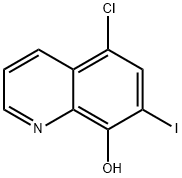클리오퀴놀 C화학적 특성, 용도, 생산
화학적 성질
Almost white, light yellow, brownish-yellow or yellowish-grey powder.
용도
Clioquinol is used as an anti-infective agent; antiamoebic agent; intravaginal trichomonacide; used to impregnate cotton bandages for antibacterial purposes; in animals as an intestinal anti-infective agent.
Indications
Iodochlorhydroxyquin (Clioquinol), containing 40% iodine, was originally developed
as a substitute for iodoform as an antiseptic dusting powder. Although its
most effective use is in the treatment of amebiasis, it also has mild antibacterial
and antifungal effects and may be used alone or with steroids in the treatment
of eczematous and impetiginized processes and some dermatophyte, yeast, and
Trichomonas infections. However, more specific agents are available. Because of
neurotoxicity, the oral form of this drug has been withdrawn in the United States.
A recent study demonstrating significant percutaneous absorption when applied to
intact human skin raises concern regarding its topical use as well. The medication
may stain the skin, hair, and clothing yellow and may induce contact allergy.
정의
ChEBI: A monohydroxyquinoline that is quinolin-8-ol in which the hydrogens at positions 5 and 7 are replaced by chlorine and iodine, respectively. It has antibacterial and atifungal properties, and is used in creams for the treatment of skin infections. It has al
o been investigated as a chelator of copper and zinc ions for the possible treatment of Alzheimer's disease.
World Health Organization (WHO)
Clioquinol, a halogenated hydroxyquinoline derivative, was
introduced into medicine around 1900 as a topical antiseptic and in 1934 oral
preparations for the treatment of amoebic dysentery and simple diarrhoea became
available. By 1964 its use in Japan had been associated with cases of sub-acute
myelo-optic neuropathy (SMON) which reached epidemic proportions resulting in
its withdrawal there in 1970. Although relatively few cases of SMON were
documented elsewhere, clioquinol was subsequently withdrawn from use in many
countries and placed under prescription control in others. It was phased out
worldwide by the major manufacturer between 1983 and 1985 on grounds of
obsolescence. No adequately controlled evidence was ever generated to
demonstrate that clioquinol is effective in bacterial or viral diarrhoea. However,
products containing clioquinol and related halogenated hydroxyquinolines
continue to be used in some tropical and subtropical countries where amoebiasis
remains endemic. Other amoebocides are preferred in the WHO Model List of
Essential Drugs.
(Reference: (WHODI) WHO Drug Information, 77.1, 9, 1977)
일반 설명
Cream-colored to brownish-yellow powder. Practically odorless. Decomposes at 178-179°C. Used as a topical anti-infective.
공기와 물의 반응
Insoluble in water.
반응 프로필
Clioquinol is incompatible with strong oxidizing agents, strong acids, acid chlorides and acid anhydrides . Darkens on exposure to light.
화재위험
Flash point data for Clioquinol are not available; however, Clioquinol is probably combustible.
Clinical Use
5-Chloro-7-iodo-8-quinolinol, 5-chloro8-hydroxy-7-iodoquinoline, or iodochlorhydroxyquin (Vioform) occursas a spongy, light-sensitive, yellowish white powder that isinsoluble in water. Vioform was initially used as a substitutefor iodoform in the belief that it released iodine in the tissues.It has been used as a powder for many skin conditions,such as atopic dermatitis, eczema, psoriasis, and impetigo.A 3% ointment or cream has been used vaginally as a treatmentfor Trichomonas vaginalis vaginitis. The best use forVioform is in the topical treatment of fungal infections suchas athlete’s foot and jock itch. A combination with hydrocortisone(Vioform HC) is also available.
Safety Profile
Poison by ingestion.
Moderately toxic by intraperitoneal route.
Human systemic effects by ingestion:
change in central nervous system electrical
function, optic nerve damage, and changes
in vision. Experimental teratogenic and
reproductive effects. Human mutation data
reported. When heated to decomposition it
emits very toxic fumes of Cl-, I-, and NOx.
Purification Methods
It crystallises from AcOH or xylene and dry it at 70o in vacuo.[Beilstein 21 III/IV 1190.]
클리오퀴놀 준비 용품 및 원자재
원자재
준비 용품







